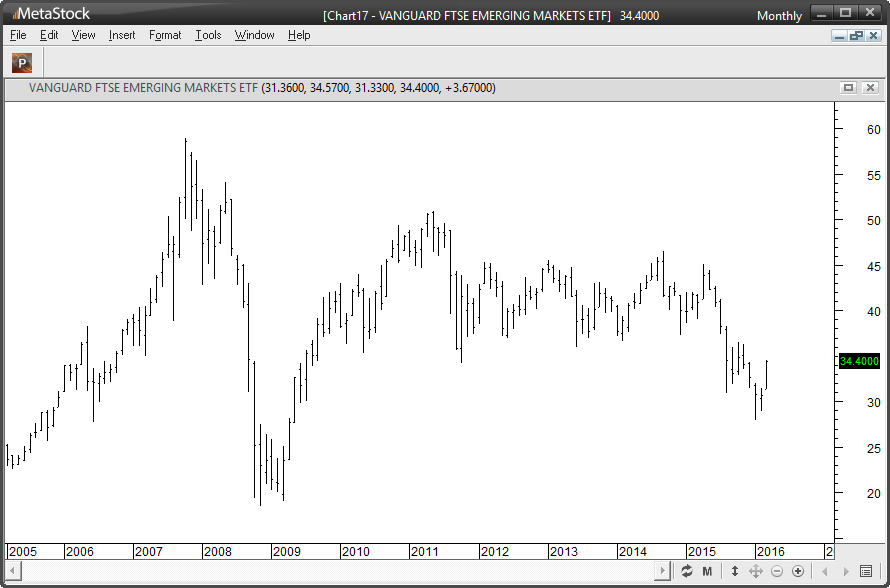Friday, a Bloomberg TV announcer said emerging markets are now in a Bull phase. Don’t get overly excited by that call. I know why they said that, but question the utility of their definition.
Vanguard’s emerging markets ETF, VWO, for example, closed at $34.40, up 11.2% from is multi-year closing low of $30.74; and up 22.9% from its multi-year low intra-day price. The former is not a Bull, and the latter, even if that is a reasonable way to measure, is not a Bull in the overall price history of the ETF.
It is well accepted that a 20% decline from a high is a Bear; but it is less well accepted that a 20% rise from a bottom is a Bull. However, let’s consider some hypothetical extremes first.
Let’s say a $100 stock grinds down to $10 within 12-months or less. If that stock rose to $12 (up 20%), Bloomberg would have to call that a Bull, even though it was 88% below its high.
That contrasts greatly to a $100 stock that declines to $80 (the Bear threshold) and then climbs to $96 (a 20% rise). Maybe that is a Bull.
Some other qualitative factor needs to be present, in my view, to call a Bull after a Bear.
That, to me, involves at a minimum bringing the trend line into the picture, if not the relationship of the price to the trend line.
If that $100 stock that went to $10 and stayed there for a year, and then went to $12 – now maybe that is a Bull – because by then the trend line would be in the vicinity of $10 and the rise to $12 becomes more meaningful.
So now let’s look at Vanguard’s emerging markets ETF to see if a Bull is realistic.
Here is simple monthly chart (where the last price bar is month-to-date) over many years. Visually, without any technical aids, it is hard to think of the March price action as a return to Bull status.
Here is 14 month chart. OK, maybe the last price bar looks like a big improvement, because it is above the trend of the closes, as you can visualize without aids.
Now let’s look at it through the lens of some technical filters. Without even explaining all the extra plots on the chart, it starts to look a lot less appetizing, and not so Bullish.
Emerging markets may pose a trading opportunity, perhaps the recent rise will continue and become what we would accept as a Bull, but for now it is at best a counter-trend rally in a downward market. And, none of that considers the terrible constitutional crisis and economic problems in Brazil, or the sanctions against Russia, or the challenges in China to get past their real estate bubble and extend-and-pretend their bank loan portfolios, or the continual capital flight from those nations.
Let’s consider this last chart and see how it tells us emerging markets are not in a Bull state.
The top panel is our net market condition and phased tactical allocation modulation rating, on a scale from 0 to 100, based on four factors:
- The direction of the primary trend line (the gold line)
- The price relative to the trend line
- The changes in price relative to volume – supply/demand (dashed green line versus 50 level on left scale)
- The price relative to a time based performance test (price vs dotted red line)
We give half of the weight to the direction of the trend line, and one sixth of the weight to each of the other three factors, to arrive at the overall market condition rating shown in bold black in the upper panel.
You can see that:
- The trend direction is down (Bearish)
- The price is below the trend line (Bearish)
- The demand/supply ratio is under 50 (Bearish)
- The price is blow the time & performance threshold (Bearish)
Buying into emerging markets at this point is a speculative approach. Not wrong, but speculative; and should not be done on the basis of an off the top of the head TV declaration of a Bull without a more in-depth look at the total price behavior picture.
A lower risk way to enter emerging markets or any other market is to do it in stages. One way to move in stages would be to modulate exposure to each risk category based on a variable indicator of the trend strength of each category. We posit that our 4 factor tool is one reasonable tool for guiding a staged shift of allocation within a category, relative to your long-term policy allocation for each category.
In closing, here are the market condition ratings using the same tool for the leading S&P 500 ETF, its 9 sector ETFs; the soon to be declared 11th sector ETF (for real estate equities) and the stock ETFs for the world excluding the US, emerging markets, and China (the largest component county weight within the emerging markets index):
- 17 – S&P 500 (NYSE:SPY)
- 17 – Materials (NYSE:XLB)
- 0 – Energy (NYSE:XLE)
- 0 – Financials (NYSE:XLF)
- 80 – Industrials (NYSE:XLI)
- 100 – Technology (NYSE:XLK)
- 100 – Consumer Staples (NYSE:XLP)
- 100 – Utilities (NYSE:XLU)
- 17 – Health Care (NYSE:XLV)
- 100 – Consumer Cyclicals (NYSE:XLY)
- 80 – Equity REITS (NYSE:VNQ)
- 0 – World excluding US (NYSE:VEU)
- 0 – Emerging Markets (NYSE:VWO)
- 0 – China (NYSE:GXC)
These are trend following ratings, not based on any other technical parameter. They are not fundamental ratings or valuation ratings or thematic ratings. These are purely and simply statements of the status of the trend at this time. To the extent that most of the time (but not all of the time) the near-term future resembles the short-term past, these trend ratings may be predictive. However, they do not make suggestions about long periods of time. They are tactical ratings for allocation shifting within and around long-term policy allocation levels for each asset category.
For example, when you look at the S&P 500 and its sector ETFs through a valuation filter using the PEG ratio (P/E ratio divided by estimated 5-year earnings growth rate), as a measure of GARP (growth at a reasonable price), you get a different picture (where lower is better, and more than 2 is expensive):
- 1.98 – S&P 500 (SPY)
- 3.18 – Materials (XLB)
- NMF – Energy (XLE)
- 1.68 – Financials (XLF)
- 1.64 – Industrials (XLI)
- 1.37 – Technology (XLK)
- 2.53 – Consumer Staples (XLP)
- 3.86 – Utilities (XLU)
- 1.97 – Health Care (XLV)
- 1.20 – Consumer Cyclicals (XLY)
If you consider trend status and the cost of growth together, Industrials, Technology, and Consumer Cyclicals look like the best current bets. We will likely add exposure in these areas. Utilities and Telecom (not available in an S&P 500 sector ETF) are both expensive in PEG terms, but are trending nicely. As yield oriented sectors, they are expected to suffer when interest rates rise.
Investors can make other arguments for other sectors based on fundamental, valuation or themes. For example, Energy pops out as a recovery story when oil prices i; and Financials are expected to do well when interest rates begin to rise.
We will look at and write about some related breadth data and valuation data for US indexes, sectors and industries in the next several days.
In the meantime, don’t take TV host analysis of emerging markets as in a Bull market totally on board, without considering the information in this note.



